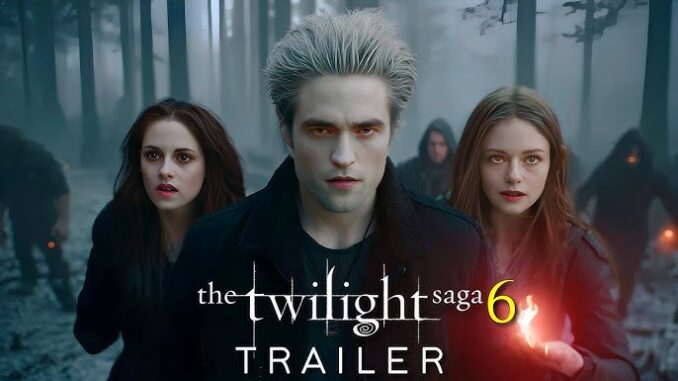
The Glittering Re-Emergence: Why Twilight Still Captivates Gen Z
The pacific Northwest, perpetually shrouded in a mist of melancholic gray, once again beckons. The familiar strains of Carter Burwell’s score, tinged with a delicate yearning, whisper from laptop speakers across the globe. Twilight, the saga that once divided a generation into fervent fans and eye-rolling critics, has experienced a sparkling resurrection, captivating Gen Z and sparking a veritable vampire romance revival on streaming platforms. What is it about this tale of a clumsy human girl and her impossibly beautiful, diamond-skinned vampire that, years after its initial pop culture saturation, continues to ensnare the hearts and algorithms of a new, digitally native audience? The answer lies in a fascinating confluence of Gen Z’s unique cultural lens, the irresistible allure of escapist romance, and the democratizing power of streaming.
For many within Gen Z, Twilight isn’t a relic of their elder siblings’ or parents’ youth; it’s a discovery. Born into a world often characterized by anxiety, digital saturation, and a constant feed of real-world pressures, the saga offers a potent dose of comfort and escapism. There’s a delicious irony in a generation so attuned to global crises finding solace in a story whose central conflict revolves around whether a vampire should date a human. Yet, this very predictability and melodrama are precisely its charm. It’s a low-stakes, high-emotion fantasy – a cozy blanket woven from supernatural intrigue, forbidden desire, and the eternal “Team Edward” vs. “Team Jacob” debate. Streaming services like Netflix and Hulu, with their endless libraries, serve up Twilight as a readily available comfort watch, a familiar world to dive into when the weight of reality feels too heavy. It’s the digital equivalent of an old fairytale, albeit one with significantly more dramatic stares and intense declarations of love.
Beyond comfort, Gen Z approaches Twilight with a sophisticated, dualistic gaze that embraces both earnest appreciation and memetic humor. This is a generation fluent in irony, capable of loving something “problematically” or enjoying its “cringe” elements without dismissing its genuine emotional core. Bella Swan’s perpetually agape mouth, Edward Cullen’s broody intensity, Jacob Black’s unwavering loyalty – these aren’t just characters; they’re meme generators, TikTok soundbites, and fodder for endless online discourse. The infamous “lion and the lamb” line, once delivered with utmost seriousness, is now reinterpreted through filters and ironic captions, a testament to Gen Z’s ability to extract joy from both the sincere and the exaggerated. They understand the underlying yearning for extraordinary love, the desire for someone to see you completely and wholly, even as they chuckle at the literal absurdity of a sparkling vampire. It’s a testament to their embrace of authenticity, even if that authenticity comes wrapped in a layer of playful mockery.
Crucially, Twilight serves as a powerful gateway to the enduring appeal of vampire romance. Before Twilight, vampires were often confined to gothic horror or seductive villainy. Stephenie Meyer democratized the monster, making him relatable, vulnerable, and, yes, utterly desirable. Edward Cullen, for all his problematic possessiveness, offered an image of eternal devotion, superhuman strength, and a gaze that promised to pierce your soul. For a generation navigating the complexities of modern relationships, the idea of an immutable, passionate, and forever love, even if tinged with danger, remains intoxicating. The “us against the world” mentality, the thrill of the forbidden, and the transformation from ordinary to extraordinary resonate deeply. This re-engagement with Twilight has not only re-lit the fire for the original saga but has also directly fueled a broader revival of the vampire romance genre, prompting a surge in similar content on streaming platforms. We see this in the popularity of shows like First Kill, Wednesday (with its monster-romance undertones), or even the renewed interest in older vampire series. The thirst for brooding immortals, dangerous secrets, and passionate, often fraught, relationships is alive and well, largely thanks to the path paved by the Forks coven.
The streaming resurgence itself is, of course, the vehicle. Without the omnipresent availability on major platforms, Twilight might have remained a nostalgic whisper. But the ease of access allows for casual viewing, deep-dive rewatches, and the organic virality that ignites online communities. A Gen Z’er can stumble upon it, share a clip on TikTok, spark a thread on Twitter, and suddenly, a decade-old franchise is trending again. The algorithms, ever-attuned to user engagement, then push more similar content, creating a feedback loop that amplifies the phenomenon. It’s a digital campfire around which a new generation gathers, collectively experiencing, dissecting, and celebrating a story that transcends its initial criticisms.
In essence, Twilight‘s continued hold on Gen Z is a fascinating case study in pop culture’s cyclical nature. It’s a story whose core themes of identity, belonging, and passionate love are timeless. Filtered through Gen Z’s unique blend of ironic distance and genuine emotional resonance, and amplified by the boundless reach of streaming, Twilight isn’t just a relic; it’s a living, sparkling entity. It reminds us that even the most derided sagas can find new life, new meaning, and new fervent fans, proving that sometimes, all it takes is a little bit of supernatural romance and the endless scroll of a screen to captivate a new generation’s heart. The rain-slicked roads of Forks may be eternally gray, but the future of vampire romance, it seems, is brilliantly, dazzlingly bright.
